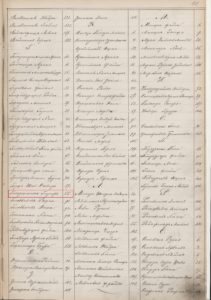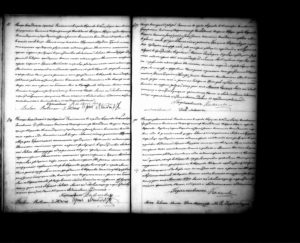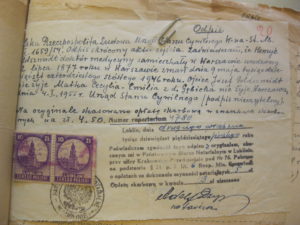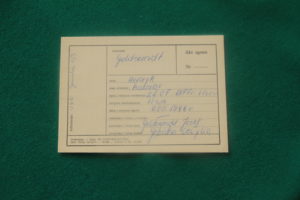Henryk Goldszmit (Janusz Korczak)
The son of Józef Goldszmit and Cecylia née Gębicka; born in 1878 or 1879, in Warsaw (registered in the Registry Office in July 1881); died in the extermination camp in Treblinka, probably on 5/6 August 1942.
Neither the original nor a copy of Henryk Goldszmit’s birth certificate has been found yet. A few years ago, however, the registry book where this certificate was registered was uncovered. Korczak himself pointed out the trail in the search for the certificate. In the diary he kept in the ghetto, several days before his death, on 21 July 1942, he wrote, “Tomorrow is my 63rd or 64th birthday. My father did not register me for a couple of years. […] My mum called it unpardonable negligence; as a lawyer, my father should not have postponed my registration.” Thus, the writer believed to have been born either in 1878 or in 1879. His lack of confidence regarding the two dates was confirmed in earlier military documents by the year-of-birth spaces he had filled (for instance, the documents concerning the course of his service in the tsarist army in the years 1905–1906, stored in the Central State Military and Historical Archives in Moscow, include record sheets with personal data, and within a one month-period, in some sheets the year of birth is given as 1878, while in others as 1879). If he himself did not know when he was born, it is rather unlikely that the date will be conclusively determined. It is known, however, that Józef Goldszmit delayed the registration of his son for a couple of years. Thus, the registry books of the district, which included Bielańska Street, where Henryk was born at the end of the 1870s, did not register the birth of the future educator. We had to look for further records. It turns out that Mr Goldszmit registered his son only after the family moved to Krakowskie Przedmieście in 1881 (according to the inventory of the State Archives in Warsaw, the street was part of District I/XI). At the end of the well-preserved book of the registry office records for Jews, we can find the name Гольдшмитъ Генрикъ in the registry of births and a reference to certificate No. 88. The number of the certificate is confirmed in the documents concerning the military service in the tsar’s army, commented upon by Kinga Sienkiewicz. Her documentary sketch, written in Russian, and its Polish translation, entitled Przyczynek do biografii Janusza Korczaka. Przebieg jego służby wojskowej w wojnie rosyjsko-japońskiej 1904–1905 roku. (Kronika) (Towards a Biography of Janusz Korczak: The Course of his Military Service in the Russo-Japanese War of 1904–1905. A Chronicle) are both available in Warsaw’s Korczakianum.
So, the registry book exists. Unfortunately, one of its pages is missing – the page containing, among other items, the lost certificate. Still, the index allows to determine the basic facts: when and where the father registered the son, and under what name and surname. It is now known that he gave the child a Polish name – we can thus exclude the theory proposed by Joanna Olczak-Ronikier, the author of the last biography of Korczak. According to this theory, Józef Goldszmit “acted against his better judgment but in accordance with his own convictions. His son was officially named Hirsz” in the unpolonised version, after his grandfather Hirsz (Hersz) Goldszmit. The Polish spelling of the surname is also confirmed (“Goldszmit,” and not “Goldszmidt” – this was the only form used by Korczak himself).
The certificates preceding the missing page (i.e. certificates Nos. 83 and 84, as well as the documents following it (Nos. 89 and 90) come from the summer of 1881. Certificates Nos. 85, 86, 87, and 88 are missing. Certificate No. 89, the one directly following Goldszmit’s certificate, was issued on 20 July (New Style). Hence, the father came to the office with little Henryk definitely after 1 July (New Style) (certificate No. 84) but not later than on 10 July 1881 (certificate No. 89). According to the aforementioned military documents examined by Kinga Sienkiewicz, the date of birth copied by the clerk from birth certificate No. 88 to the military files was 10 July 1879 (Old Style), which is equivalent to 22 July in the Gregorian calendar. It is thus probable that, during the registration in July 1882, the father told the clerk that his son was two years old. However, he had to give the exact date and even the precise time of birth. He probably gave the date which was close or even the same as the date of arrival at the office, and it did not matter in accordance with which style the clerk wrote down the date because the date was just an estimate (the father had to give some date, as well as the time of birth). If Korczak himself did not know how old he was in 1942, we can assume that no one in his family remembered his exact date of birth or there was no agreement about it. Some remembered that it was in 1878; others that in 1879 – perhaps he was born at the turn of these years, in winter. December 1878? January 1879? Unfortunately, we are unable to determine the exact date even if the copy of the birth certificate is found.
Similarly, it is impossible to determine the precise date of Henryk Goldszmit’s death. Did he die on his way to Treblinka, in a crowded “cattle” car, or at the place of execution, in a gas chamber? Or perhaps he was executed by a firing squad, together with other old and ill prisoners, in the so-called hospital on 5 or 6 August. We will never know this. Agnieszka Witkowska writes about it in “Ostatnia droga mieszkańców i pracowników warszawskiego Domu Sierot” [The Road to Death of the Residents and Employees of the Warsaw Orphanage], Zagłada Żydów. Studia i Materiały 2010, vol. 6).
There are, however, judicially determined birth and death dates of Henryk Goldszmit’s life: 22 July 1877 – 9 May 1946. Even though they have nothing to do with reality, the procedure used for determining them seems so interesting that it is worth recalling. The author of these dates is Janina Gołębiowska, the granddaughter of Magdalena (Mindla) Rajner née Goldszmit. After the war, Gołębiewska found herself in a very difficult financial situation, so she started to make efforts in order to acquire the copyrights after her famous uncle. For that purpose, she had to prove not only that they were related but also the fact that he was dead. In order to recognise somebody as deceased, the court has to be certain that this person was born. Yet, the relative obviously did not have the writer’s birth certificate.
In 1948, she knew next to nothing about her uncle. In the Polish Authors’ Association ZAIKS membership declaration for the rights holders (in 1948, Korczak became the extraordinary member of this organisation through her), she wrote “the years of the occupation 1939–1940/41” in the field for “possible date of death of the author.” In her letter to the Warsaw Medical Chamber (Warszawska Izba Lekarska), she enquired about his parents’ first names and the maiden surname of his mother. In September 1953, in the petition to declare him deceased, she was more knowledgeable – she indicated 22 August 1942 as the date of the transportation of his orphanage, Dom Sierot, to Treblinka. What is interesting, she quoted the book by Hanna Mortkowicz-Olczakowa, whose first sentence states, “The legend was born in the morning of 5 August 1942.” A couple of pages later in her book, Mortkowicz-Olczakowa, on the basis of the much quoted writer’s diary (which was then still stored as a typescript), concluded that Korczak was born on 22 July 1878 or 1879. In the abovementioned petition, Gołębiewska without hesitation indicated the year 1878. Although she spelt the name correctly as “Goldszmit,” somebody in the court changed the spelling. From then on, the official spelling of Korczak’s name in the court records was “Goldszmidt.” We may find it surprising that in the course of further proceedings, Gołębiewska petitioned the court to reconstruct Korczak’s birth certificate for the year 1879. It is completely incomprehensible, however, that during the court proceedings on 16 March 1954, Gołębiewska testified that Henryk Goldszmidt was born on 22 July 1877! How did she know that? The court records do not mention anything in that regard. In the substantiation of the court sentence, we can read that “The essential content of Henryk Goldszmidt’s birth certificate has been unambiguously determined in the course of judicial proceedings, on the basis of witness testimony (given by Stanisława Łaguna and the petitioner).” Here is the entire testimony of a certain Stanisława Łaguna (“aged 62, an office worker, a stranger”): “I knew Henryk Goldszmidt only from the stories told by the petitioner’s grandmother, called Rejner, the resident of Warsaw, who claimed that he was her relative, a professional writer, but I don’t know his date and place of birth.”
Gołębiewska, on the other hand, testified under oath that:
her uncle’s birth certificate was issued by the Registry Office for Non-Christian Religions (Urząd Stanu Cywilnego dla wyznań niechrześcijańskich) in the year of his birth. […] The Warsaw Registry Office searched for his birth certificate, but the registers for this district, i.e. the Old Town, for non-Christian religions have not been found. The year of birth indicated in the petition [i.e. 1879] was incorrect as the actual year of Henryk Goldszmidt’s birth was 1877.
In accordance with the petitioner’s clues, the officers were looking for the registers from the 5th Police Station in Warsaw for the year 1879. But, until 1881, the Goldszmits lived on Bielańska Street, which was part of the 2nd District. It might be an irrelevant detail because no registers from the 2nd District survived the war, but the entire judicial procedure demonstrated an exceptional lack of concern on the part of the court. The fact that the dates were inconsistent, that the evidence given by the second witness did not confirm anything, and that the court did not take other proof – such as the biography quoted by the petitioner – into consideration, all of these seemed like major malpractice. After all, this case concerned a very famous man.
A few months later, in July 1954, an announcement appeared on the official notice board for announcements (Urzędowa Tablica Obwieszczeń) in Warsaw:
Concerning the initiation of the proceedings with the aim to declare Henryk Goldszmidt, born 22 July 1878 [sic!], deceased […]. The court summons the missing person to appear in the court which conducts the proceedings within three months from the publication of this announcement; otherwise, he may be declared deceased. The court summons all persons who have the knowledge of the missing person to inform the court of this fact by that date.
Nobody reported. In November, the court decided “to declare him deceased as of 9 May 1946.” In the substantiation of the sentence we can read that:
According to the testimony given by the petitioner, in 1942, her relative […] was transported by the Germans to the camp in Treblinka and he has not been seen ever since. […] The announcements concerning the initiation of the proceedings have been published in Monitor Polski as of 24 June 1954 (No. B-26) and […] in the Presidium of the Municipal National Council of Warsaw. All the time limits prescribed by the law expired, and so the petition had to be granted as legally substantiated.
What is probably meant here is Article 18 of the General Articles of Civil Law, in connection with Article XVI of the Implementing Articles, which state that a person who went missing during the Second World War and who was imprisoned in a place where their life was especially endangered is declared deceased one year after the war activities were finished in Europe. A puzzling issue might be the interpretation of the then-binding Article 18 of the Decree on Personal Law as of 29 August 1945, which states:
- 1. It is assumed that the missing person died at the time indicated in the sentence declaring the person to be deceased.
- 2. The time of death is believed to be the time which is most probable in the circumstances.
- 3. If it is impossible to determine such time, it is assumed that the missing person died on the last day of the period after which a person can be declared deceased.
The court decided that it is impossible to determine the most probable time of death. The court did not refer to any documents confirming or specifying Gołębiewska’s testimony, not even the obituaries that were published in the press (from 1943 several dozen obituaries commemorating the Doctor were published, for instance, “Kres wędrówki Janusza Korczaka” [The End of Janusz Korczak’s Journey], Robotnik 1945, “Śmierć Janusza Korczaka” [The Death of Janusz Korczak], Rzeczpospolita 1945, or “O Januszu Korczaku. W dziesiątą rocznicę śmierci” [About Janusz Korczak: On the Tenth Anniversary of His Death, Słowo Tygodnia 1952]). By 1954, four books concerning Korczak were published, containing his more or less accurate biography. His biographical notes were published even before the war, for instance in encyclopaedias (e.g. Rocznik Naukowo-Literacko-Artystyczny na rok 1905 [The Literary, Scientific and Artistic Yearbook for the Year 1905], Władysław Okręt, Warsaw 1905; Wielka Encyklopedia Powszechna Ilustrowana [The Great Popular Illustrated Encyclopaedia], vol. 37, series I, Warsaw 1905; W. Feldman; Współczesna literatura polska 1864–1907 [Modern Polish Literature 1864–1907], Warsaw 1908; Ilustrowana encyklopedia Trzaski i Michalskiego [Trzaska and Michalski’s Illustrated Encyclopaedia], Warsaw 1926; Wielka ilustrowana encyklopedja powszechna [The Great Illustrated Public Encyclopaedia], vol. 5, Gutenberg Publishing House, Kraków 1930). In 1946, the Committee to Commemorate Janusz Korczak (Komitet Uczczenia Pamięci Janusza Korczaka) was founded and began its work to honour his life and work.







